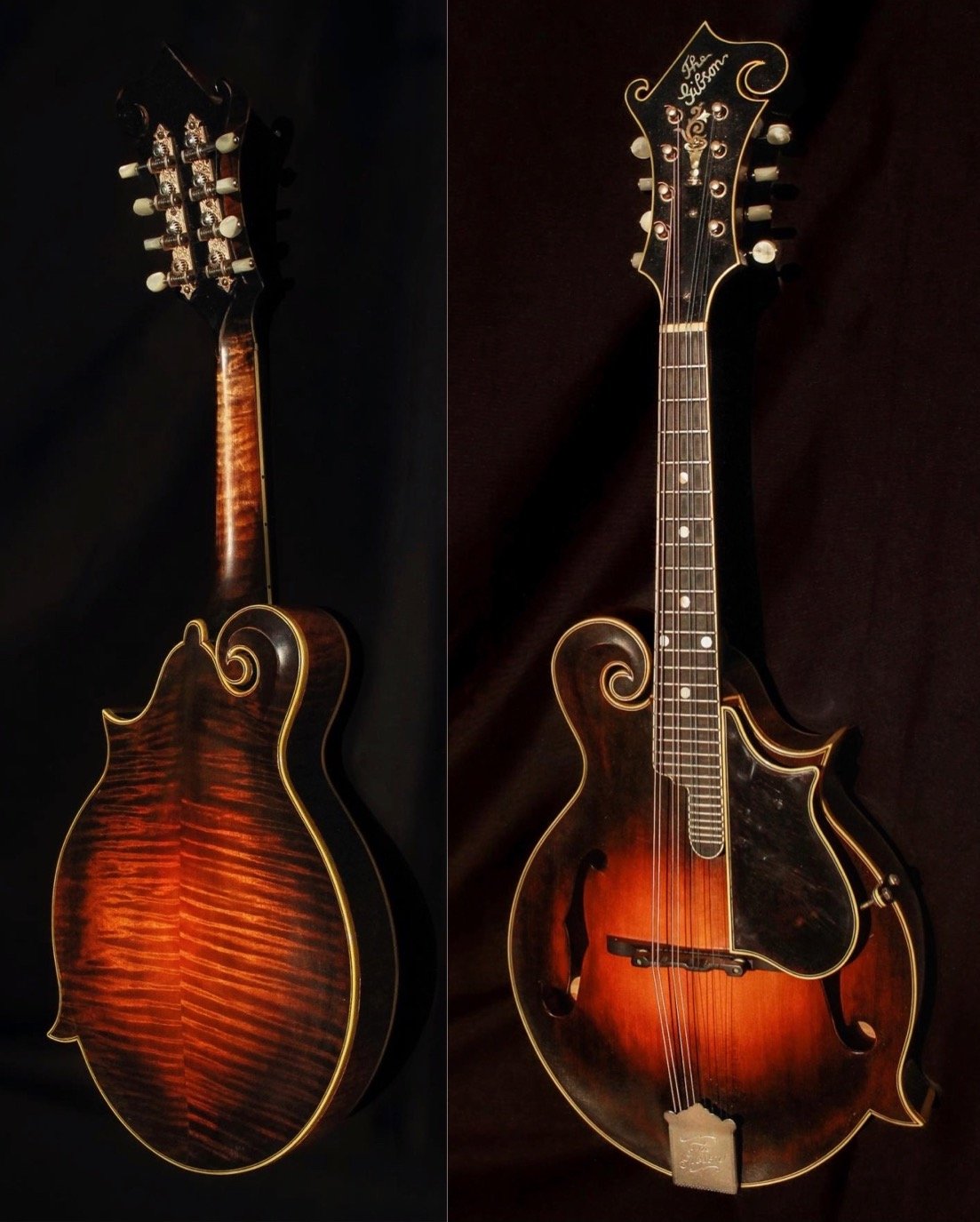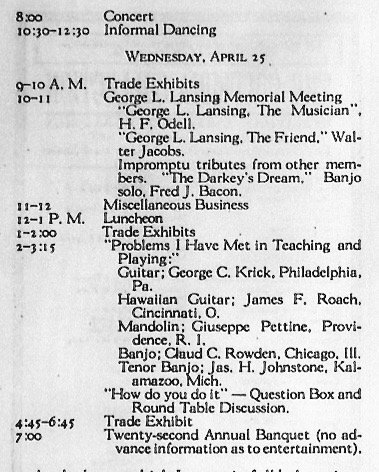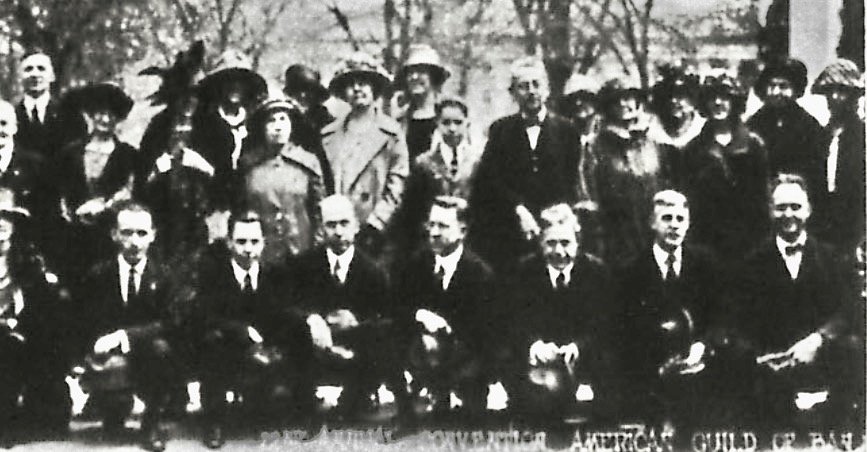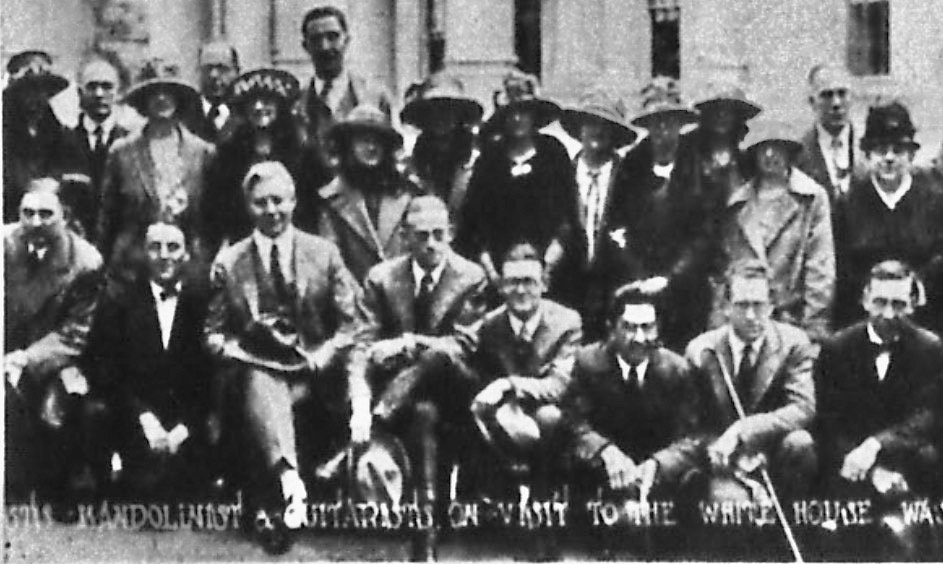Gibson F-5 73006, signed by Lloyd Loar and dated April 25, 1923. (Photos by Emma McCoury, courtesy Ronnie McCoury)
Left to Right: Marguerite Lichti, H-5 mandola; Ethyle Hindbaugh Johnstone, F-5 mandolin; James H. Johnstone, mando-bass; Charles A. Templeman, K-5 mando-cello; Lloyd Loar, MV-5 mandolin/mandola. Photo taken at 2 pm, Monday, April 23, 1923, in front of the White House in Washington, D.C.
The last week of April in 1923 was an auspicious time for the Gibson Master Model mandolin family of instruments: the official debut was scheduled for the Convention of the American Guild of Banjo, Mandolin and Guitar. On the night of April 25, Lloyd Loar and the Gibsonians with Fisher Shipp performed for the leaders of the plectrum world in the “Grand Concert For The Annual Banquet.”
In Kalamazoo, we know of fourteen F-5 mandolins, numbered 73002 through 73015, that were either finished or nearing completion. Each contained a label dated April 25, 1923, signed by Lloyd Loar. Some of those found their way into the hands of extremely significant players, including Dave Apollon, Nancy Blake, Byron Berline, Herschel Sizemore and Ronnie McCoury.
Labels in Gibson F-5 73006. (Photos by Emma McCoury, courtesy Ronnie McCoury)
At this point, we have examined labels in nine of the fourteen. The signatures and dates are consistent with the handwriting identified with Lloyd Loar. The serial number in each is written very neatly in ink. In other F-5s from 1923 that we have examined, the serial numbers are in pencil (so far, in our current chronological examination, only the very first known label, 70281, has a serial number in ink). How is it possible that Lloyd Loar could sign labels for mandolins in Kalamazoo and be in Washington D.C.? Why has the very consistent serial number signer switched to pen for just this one batch and returned to pencil afterwards? Or, has a different person undertaken the task of filling in the serial number labels for these fourteen? Thus begins our search for answers to an intriguing mystery that may actually shape how we imagine the labeling process.
Signature label on 73014. (Photo courtesy Steve Gilchrist.)
Serial number label on 73005. (Photo courtesy Tom Isenhour.)
Compare the April 25 labels to earlier labels:
Signature label from F-5 72857.
Serial number label from F-5 72060 in pencil.
Serial number in pencil on label in F-5 72211.
Signature and date in 72211.
Both labels in ink from 70281. (Photo courtesy Steve Gilchrist)
The adventure began on Saturday, April 21. Lloyd Loar, Lewis A. Williams, C.V. Buttleman and Ethyle and James Johnstone undertook the 16-hour ride on the Capital Express from Chicago to Washington D.C. They, and possibly additional Gibson personnel, were stewards of a “considerable collection of mandolins, mandolas, mando-cellos, harp guitars, mandolin-banjos, tenor banjos, cello-banjos” and at least one mando-bass. (Cadenza, July 1923) By Sunday afternoon, an exhibit of those instruments, along with framed photographs of Gibson endorsers from all over the world, was ready for view in the Raleigh Hotel on 12th Street, N.W. and Pennsylvania Avenue. During the hours in which the exhibit hall was open, Loar and Johnstone were on hand to greet the public, demonstrate the instruments, and most especially, to show off the new F-5, H-5 and K-5 models. Lloyd Loar figured prominently in the proceedings as he took part in meetings and concerts as well as the Gibson exhibit. Charles A. Templeman and Marguerite Lichti , from Sioux City, Iowa, arrived to complete Gibson’s instrumental team. It is unclear when Fisher Shipp, aka Mrs. Lloyd Loar, arrived, as her appearance is not documented until the final concert on Wednesday evening, April 25. Thanks to detailed accounts in both Cadenza and Crescendo magazines, which we have carefully cross-referenced for accuracy, we are able to present the following account of the events as they were planned and what actually took place.
Raleigh Hotel, 12th Street, N.W. and Pennsylvania Ave., Washngton, D.C., ca. 1920.
Program sent out in advance, Crescendo, April, 1923.
Program sent out in advance, Crescendo, April 1923. p. 2.
On Monday morning, April 23 at 9 am, the convention officially opened.
The first order of business was a tour of the exhibit hall. A number of future Master Model proponents were on hand, including William and Margie Griffith from Atlanta, Percy Lichtenfels from Pittsburg, Roy Veiock from New Brighton, Conrad Gebelein from Baltimore, Herman Von Bernewitz from Washington D.C. area, and Claud Rowden from Chicago. Afterwards, the keynote address by Secretary Of Labor James J. Davis and the business meeting that followed dragged on an hour past schedule. At 1pm, the members rushed down Pennsylvania Avenue to the White House to be received by President Warren G. Harding. Some of the members, including Loar and company, carried their instruments along in hopes of an audience with the President. After greeting each of the 87 people lined up to meet him, Mr. Harding declined the impromptu recital. Once the President excused himself, a photographer was ready for a panoramic group photo, which we have divided into four shots (below).
Standing 3rd from left: Charles Templeman; 4th, Marguerite Lichti; 6th and 7th, Mrs and Mr. Johnstone.
Kneeling, far right, Lewis A. Williams.
Sitting, 4th from left: Lloyd Loar; standing, back row, far right, C.V. Buttleman.
Standing, back row on left: William Griffith; back row, 3rd from left, Walla Zeller.
By this time, it was well past lunch time. Guild members hurried to Gallotti’s Italian Restaurant, except Loar, the Johnstones, Templeman and Lichti. They took time to pose with their instruments for the extraordinary photo shown above.
Crescendo, April 24, 1923.
By now the afternoon schedule had been abandoned. The family-style feast went on for some time, and as dessert was served, Signori Gallotti appeared with his trombone and serenaded the guests to the accompaniment of recorded music. It was noted that he made particularly powerful sounds. Lewis Williams must have been quite disappointed, as his afternoon lecture on radio technology, which was his new passion, was deleted from the program completely. The Monday evening concert also contained disappointments, as Samuel Siegel, who was on tour in Europe, and Giuseppe Pettine, both stars of previous conventions, had cancelled.
Monday night concert schedule, Cadenza, April 1923.
Monday night concert schedule, Cadenza, April 1923. p. 2
In the evening concert, Marguerite Lichti, the twenty year Gibsonian from Sioux City, performed in the first half.
After intermission, Lloyd Loar took the stage with his 10-string MV-5, and made a convincing argument for the additional strings.
Cadenza, July, 1923. As an aside, the act following Loar, the guitarist Johnson Bane, who played with high nut and slide, was accompanied by Margie Griffith on piano. By the end of 1923 she would own the only Loar signed A-5.
The Gibsonians continued to make appearances throughout the program. Charles Templeman was elected to the board of directors in the opening meeting. At the final business meeting on Wednesday, Lloyd Loar and James Johnstone were tasked to create “Standards of Attainment” for mandola and tenor banjo, respectively. When the meeting adjourned, the Oak Room of the Raleigh Hotel was prepared for the banquet and final concert, which went on well into the “wee hours.”
Guild convention members toward the end of the banquet, prepared for a concert that would include Lloyd Loar and the Gibsonians with Fisher Shipp.
Cadenza, July 1923. We assume that there were other selections in their concert, but at this point we have no further documentation.
Gibson F-5 73006, signed by Lloyd Loar and dated April 25, 1923. (Photo by Emma McCoury, courtesy Ronnie McCoury)
The April 25 fourteen! Incredible mandolins, mysterious labels! When? Why? Where?
During the past year, we have carefully plotted Lloyd Loar’s whereabouts; this is the first occasion where we have clear evidence that he was not at the factory during a signing date. Did he sign and date labels ahead of time, at the hotel, or after he returned? One plausible explanation, they were signed in advance to accommodate a shipping schedule. Below, we have plotted all the known signature dates from the first half of 1923 in a futile search for a pattern or schedule.
The known signature dates for F-5 in the first half of 1923. (Thanks to Dan Beimborn’s excellent “Mandolin Archive,” for making this exercise possible).
Was April 25th selected to commemorate the the Guild Convention? Did the anticipation for a boost in sales after the convention affect the process? (There is evidence that the exhibit did create demand for the F-5. All the artist/teacher/agents mentioned above purchased and/or brokered multiple Master Models over the next few years). Why the pen with the extra fine nib instead of pencil?
These are extraordinary instruments, and our devotion to this study will continue as we search for greater understanding. Let us hear from our readers: What do you think?
Gibson F-5 73006, signed by Lloyd Loar and dated April 25, 1923. (Photo by Emma McCoury, courtesy Ronnie McCoury)
Gibson F-5 73006, signed by Lloyd Loar and dated April 25, 1923. (Photo by Emma McCoury, courtesy Ronnie McCoury)
In putting together this episode, I am deeply indebted to the following friends: Steve Gilchrist, for images, ideas, exhaustive knowledge, and his unswerving support of this project from the beginning; Tom Isenhour for images, knowledge of the mandolins, ideas and readiness to help; Darryl Wolfe (F-5 Journal) and Dan Beimborn (Mandolin Archive) whose works I keep at my fingertips; Scott Tichenor for his support through the incredible resource at Mandolin Cafe, and especially Ronnie McCoury for sharing his great mandolin and Emma McCoury for the breathtaking photos! Thank you all! I’ll be back next month with another episode of Breaking News 1923!



























